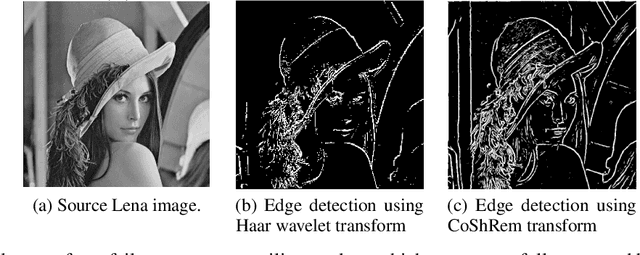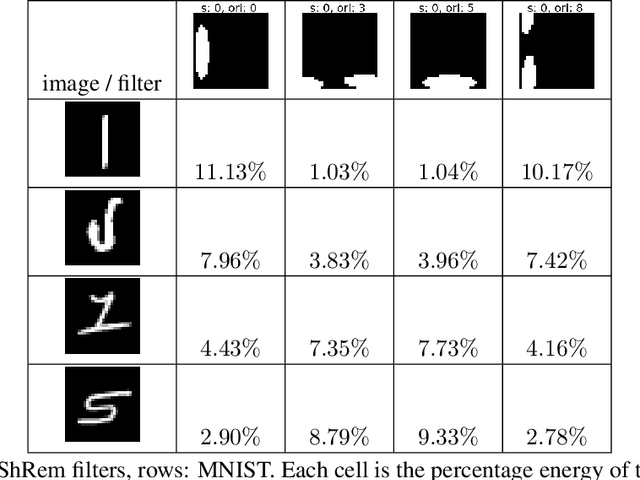Héctor Andrade-Loarca
CoShNet: A Hybird Complex Valued Neural Network using Shearlets
Aug 14, 2022



Abstract:In a hybrid neural network, the expensive convolutional layers are replaced by a non-trainable fixed transform with a great reduction in parameters. In previous works, good results were obtained by replacing the convolutions with wavelets. However, wavelet based hybrid network inherited wavelet's lack of vanishing moments along curves and its axis-bias. We propose to use Shearlets with its robust support for important image features like edges, ridges and blobs. The resulting network is called Complex Shearlets Network (CoShNet). It was tested on Fashion-MNIST against ResNet-50 and Resnet-18, obtaining 92.2% versus 90.7% and 91.8% respectively. The proposed network has 49.9k parameters versus ResNet-18 with 11.18m and use 52 times fewer FLOPs. Finally, we trained in under 20 epochs versus 200 epochs required by ResNet and do not need any hyperparameter tuning nor regularization. Code: https://github.com/Ujjawal-K-Panchal/coshnet
Deep Microlocal Reconstruction for Limited-Angle Tomography
Aug 12, 2021



Abstract:We present a deep learning-based algorithm to jointly solve a reconstruction problem and a wavefront set extraction problem in tomographic imaging. The algorithm is based on a recently developed digital wavefront set extractor as well as the well-known microlocal canonical relation for the Radon transform. We use the wavefront set information about x-ray data to improve the reconstruction by requiring that the underlying neural networks simultaneously extract the correct ground truth wavefront set and ground truth image. As a necessary theoretical step, we identify the digital microlocal canonical relations for deep convolutional residual neural networks. We find strong numerical evidence for the effectiveness of this approach.
Shearlets as Feature Extractor for Semantic Edge Detection: The Model-Based and Data-Driven Realm
Nov 27, 2019



Abstract:Semantic edge detection has recently gained a lot of attention as an image processing task, mainly due to its wide range of real-world applications. This is based on the fact that edges in images contain most of the semantic information. Semantic edge detection involves two tasks, namely pure edge detecion and edge classification. Those are in fact fundamentally distinct in terms of the level of abstraction that each task requires, which is known as the distracted supervision paradox that limits the possible performance of a supervised model in semantic edge detection. In this work, we will present a novel hybrid method to avoid the distracted supervision paradox and achieve high-performance in semantic edge detection. Our approach is based on a combination of the model-based concept of shearlets, which provides probably optimally sparse approximations of a model-class of images, and the data-driven method of a suitably designed convolutional neural netwok. Finally, we present several applications such as tomographic reconstruction and show that our approach signifiantly outperforms former methods, thereby indicating the value of such hybrid methods for the area in biomedical imaging.
Extraction of digital wavefront sets using applied harmonic analysis and deep neural networks
Jan 05, 2019



Abstract:Microlocal analysis provides deep insight into singularity structures and is often crucial for solving inverse problems, predominately, in imaging sciences. Of particular importance is the analysis of wavefront sets and the correct extraction of those. In this paper, we introduce the first algorithmic approach to extract the wavefront set of images, which combines data-based and model-based methods. Based on a celebrated property of the shearlet transform to unravel information on the wavefront set, we extract the wavefront set of an image by first applying a discrete shearlet transform and then feeding local patches of this transform to a deep convolutional neural network trained on labeled data. The resulting algorithm outperforms all competing algorithms in edge-orientation and ramp-orientation detection.
 Add to Chrome
Add to Chrome Add to Firefox
Add to Firefox Add to Edge
Add to Edge